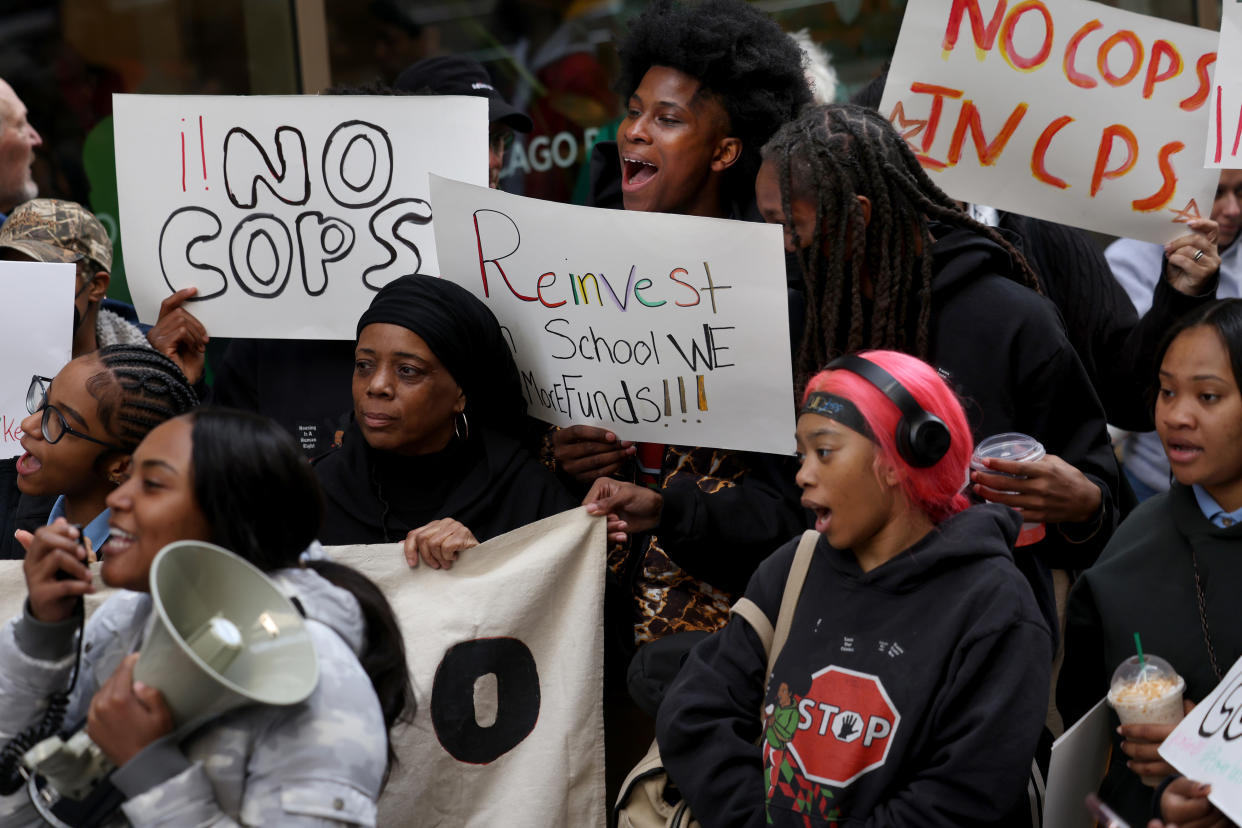As CPS begins finalizing a new policy prohibiting cops in schools, a state bill could upend the district’s plans

Chicago Public Schools moved a step closer to finalizing a new school safety policy Thursday, following a Board of Education vote in February to remove uniformed Chicago Police Department officers from all district schools as of the end of the school year.
The board approved a new “Whole School Safety Framework” presented by the district Thursday. But a state bill that could supersede the district’s plans may also be voted on this week. Sponsored by Rep. Mary Gill, D-Chicago, HB5008 would allow high school Local School Councils to contract directly with CPD to employ school resource officers, known as SROs, through February 2027.
The tension between state and local policy efforts is the latest in a long-running debate on whether a blanket, rather than school-level, decision to remove police from schools should be made.
Under the district’s $10.3 million CPD contract expiring in August, SROs are currently in about a quarter of district high schools, where LSCs have voted to have one to two officers on patrol during the school day. As of the end of this school year, the new policy mandates the end of SRO programs districtwide, with the understanding that CPS will continue to partner with CPD, “which have always, and will continue to, provide critical support for all of our schools.”
Chief of Safety and Security Jadine Chou said at the meeting Thursday that CPD has committed to maintaining School Sergeants, who’ve long been working with the vast majority of the district’s more than 600 schools which have either never had SROs or removed them.
The vote to remove all SROs made good on a 2020 district commitment to phase out their use, Board members said in February, adding that a central decision was needed to prevent proven disparities in school-based arrests from being perpetuated. Around 70 school districts nationally have adopted policies to remove police from schools, according to a 2023 Georgetown Law report.
Proponents have argued that LSCs should continue to vote on whether to keep SROs, given that different schools have different needs.
Lynn Morton of Community Organizing and Family Issues (COFI), one of four community-based nonprofits which have partnered with CPS to reshape its safety policies, recognized that removing SROs makes some community members nervous.
“Let’s keep in mind, all of us, that real discipline is about education. It’s about learning. So our dollars should be spent in areas that promote learning and education,” she said.
A new school safety framework
The proposed policy expands upon the “holistic” approach to school safety CPS adopted in 2020 when the district began incorporating community groups and students in safety planning. Adopted in the wake of racial justice protests in 2020, the reform also allowed LSCs to trade in SRO funds to invest in alternative strategies, such as hiring restorative justice coordinators.
Data on school-based arrests the district released that year showed the overwhelming majority — 73% — involved Black students, who were only 36% of students. Calls to police continue to be disproportionately higher for students with disabilities, according to the board’s February resolution.
The new policy dictates that every school must have working indoor and outdoor security cameras and at least one security officer, with the allocation of additional officers dependent upon the size of the school population and neighborhood crime rates. Schools can consider metal detectors and must also have emergency procedures in place, for which drills must be conducted with students.
CPS has historically required part-time security roles be filled by sworn police — a provision that district officials said last June would be removed in a new collective bargaining agreement with Service Employees International Union Local 73. The district did not provide comment regarding whether that provision has been lifted in an agreement with the union representing security guards and other support staff that the board also approved Thursday.
Physical, emotional and relational safety are the pillars of the district’s approach, which will be implemented in phases, Chou said at a board committee meeting last week. “That starts with a baseline assessment … working with our community partners and our stakeholders, like parents and students, to make sure that we’re understanding their needs,” she said.
Later phases entail the creation of school-level safety committees, which will develop and implement safety plans that emphasize cultivating trusting relationships between students and staff, social-emotional learning and non-exclusionary discipline, by the 2028-29 school year. “Safety cannot be defined or driven by fear-based reactions,” Morton said.
Mandatory monthly conversations between administrators and student representatives will also take place at high schools under the proposal. But whereas previously only high schools had the opportunity to create comprehensive safety plans inclusive of student and community input, the proposed policy expands the process districtwide.
More than 9,000 responses to a public survey on school safety have shaped the new draft policy, Director of Safety Operations Kylie Kosmacek said last week. The policy will next be published for public comment. In June, four community engagement sessions will be hosted by COFI and CPS’ three other community-based partners, Broader Urban Involvement & Leadership Development Inc., Mikva Challenge and Voices of Youth in Chicago Education.
“We are coming together to reimagine school safety to prioritize students’ social-emotional and physical safety and well-being in a safe environment that allows us to learn and thrive regardless of the neighborhood we live in,” Amundsen High School student Edgar Nava, a member of the Whole School Safety Steering Committee, said in a news release.

